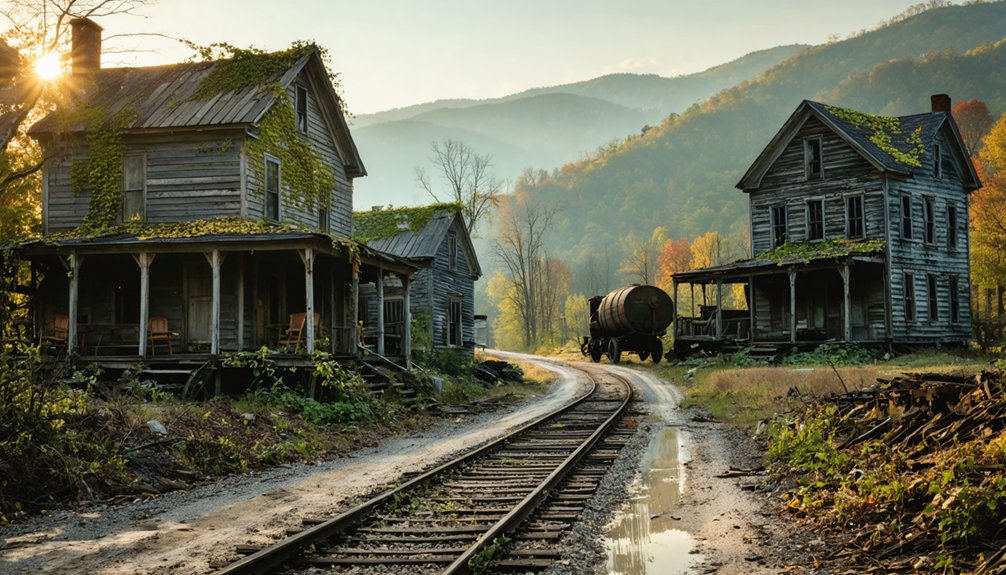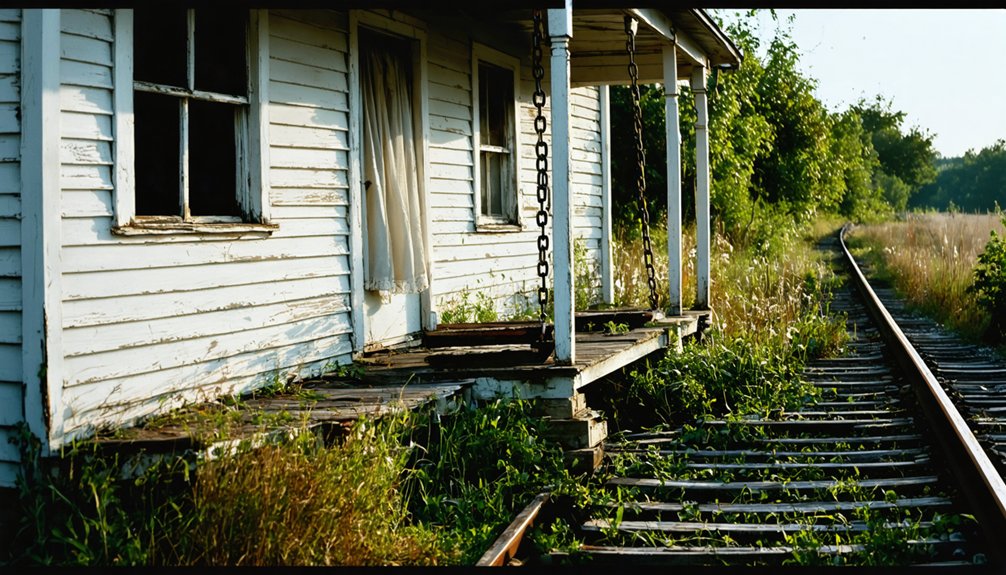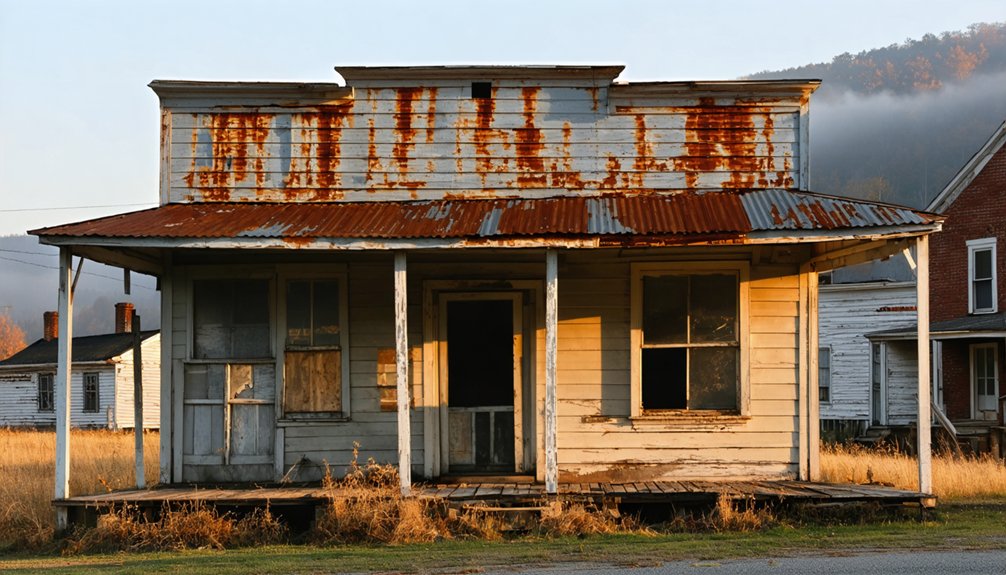You’ll find Neal, Kentucky, between the remnants of a once-bustling coal mining town established in the 1910s along the Louisville and Nashville Railroad. This Eastern Kentucky settlement thrived through the 1940s, when coal mining jobs peaked at 75,633. After WWII, automation and declining coal demand forced families to abandon their homes and businesses, leaving behind crumbling infrastructure and environmental hazards. Neal’s empty buildings and toxic legacy tell a larger story about America’s forgotten coal communities.
Key Takeaways
- Neal was established between 1910-1920 as a coal mining town in Eastern Kentucky, centered around John Neal’s 157-acre property.
- The town’s economy relied heavily on coal mining, with employment peaking at 75,633 jobs in 1948.
- Companies controlled the local economy through scrip currency, forcing miners to shop at company-owned stores.
- Post-World War II mine closures triggered mass exodus, with families abandoning homes and businesses as mining operations ceased.
- The ghost town now features crumbling infrastructure, abandoned buildings, and environmental hazards from former mining operations.
The Rise of a Mining Community

As railroads pushed into Eastern Kentucky’s rugged terrain between 1910 and 1920, Neal emerged as one of many coal towns dotting the region’s landscape.
You’ll find Neal’s story intertwined with the arrival of major railways like the Louisville and Nashville Railroad, which transformed the region’s accessibility to its rich coal seams.
The town’s community dynamics reflected the era’s rapid industrialization, as mining companies acquired vast tracts of land to establish operations. The thin, mineral-poor soils of Eastern Kentucky meant most residents couldn’t rely on farming alone for sustenance.
Like many coal camps, Neal’s cultural heritage was shaped by the influx of workers drawn to mining opportunities. Coal mining employment peaked during the early years, supporting 73,000 indirect jobs across various sectors including education and engineering.
You’d have witnessed the construction of company housing, commissaries, and social venues that formed the backbone of daily life.
The town’s prosperity hinged on coal production demands, especially during the industry’s “Golden Age” from 1900 to 1941.
Life in Early Neal
While frontier life presented numerous challenges, early Neal settlers established a modest but structured community centered around John Neal’s 157-acre property.
Settlement patterns evolved around his homestead, built in the 1790s, where you’d find well-crafted timber houses rather than crude log cabins. The homes featured brick chimneys, though construction materials like nails and window glass were scarce.
Daily life revolved around a diverse diet of pork, beef, and local game, supplemented by corn and wheat. You’d have found families sharing meals served on various sized plates, sipping tea from porcelain cups – a sign of civilized frontier living. Shaker communities nearby would later influence the region’s cultural development through their functional craftsmanship and architecture.
Frontier meals brought families together, sharing hearty meats and local harvests while sipping tea from fine porcelain cups.
The social structure included landowners, tenants, and enslaved workers, all connected by the essential transportation routes of Boone’s and Skaggs’ Traces, which brought new settlers despite Native American threats. The area underwent rapid change as Kentucky transformed from Stone Age to civilization in less than two centuries.
Economic Backbone and Industrial Heritage
While Neal’s early economic foundation relied heavily on the surrounding agricultural activities, you’ll find that its proximity to Kentucky’s coal mining regions influenced its development through auxiliary support services and trade relationships.
The town’s industrial infrastructure grew modestly to include essential facilities that served both farming and mining communities in the area. Similar to Barthell Coal Camp, Neal developed interconnected business operations to support regional mining activities. Like many mining communities, workers often relied on company scrip tokens for their purchases.
You’d have seen a mix of local commerce emerge as workers from nearby mining operations and agricultural laborers frequented Neal’s establishments, creating a small but interconnected economic ecosystem.
Coal Mining Economic Impact
Coal mining’s profound economic influence on Kentucky reached its zenith in 1948 when employment peaked at 75,633 jobs, establishing the industry as the region’s dominant economic force.
You’ll find this economic legacy woven into Kentucky’s fabric, from the first commercial mine in Muhlenberg County in 1820 to record-breaking production of 179.4 million tons in 1990.
The industry’s impact on community resilience is evident in the vast coal reserves – 105 billion tons split between the Eastern Field (64 billion) and Western Field (41 billion).
Eastern Kentucky’s coal, with its higher carbon density, proved especially valuable for electricity production.
However, by 2010, underground mining jobs had plummeted to fewer than 4,000, reflecting the dramatic transformation of Kentucky’s coal economy under pressure from environmental regulations and mechanization.
Industrial Infrastructure Development
As Kentucky’s industrial landscape evolved in the late 19th century, railroads emerged as essential arteries connecting mining operations across the region’s challenging terrain.
You’ll find that these transportation networks played a crucial role in transforming isolated communities into bustling industrial centers, particularly in areas like Whitley County where short rail lines linked coal mines to major routes. Early oil transport relied heavily on wooden pipeline systems during the Civil War period due to material shortages.
Slave labor was extensively utilized in early industrial development before the 13th Amendment abolished the practice in 1865.
The industrial legacy of this era is still visible in places like Middlesboro and Pineville, where rapid growth followed the railroad’s arrival.
Despite the hilly topography presenting significant challenges, innovative solutions emerged, including the Cumberland Gap tunnel project.
The development of these industrial hubs wasn’t limited to rail infrastructure – you’ll discover they also pioneered electric lighting systems and established extensive water networks to support their growing populations.
Workforce and Local Commerce
Neal’s industrial workforce centered on a singular economic lifeline – the coal mines that employed hundreds of skilled and unskilled laborers during the early 20th century.
You’d find workers enduring long, hazardous shifts underground while facing systematic worker exploitation through the scrip economy. Coal companies maintained tight control over the local economy, forcing miners to use company-issued currency at inflated company stores.
If you’d visited Neal during its peak, you’d have seen how the town’s commerce revolved entirely around these company-owned establishments. The National Guard patrolmen were deployed to maintain order during worker disputes over unfair pay practices. Like many other ghost towns in Kentucky, Neal’s economy was heavily dependent on coal mining operations.
There wasn’t any real competition or free market – the coal operators guaranteed their monopoly by restricting access to federal currency.
When mining operations declined, this restrictive economic system left workers with worthless scrip and few alternatives, ultimately contributing to Neal’s transformation into a ghost town.
The People Behind Neal’s Story

While many ghost towns in Kentucky trace their origins to a single founder or family name, the story behind Neal’s namesake remains shrouded in mystery.
You won’t find any official records linking the town’s name to specific founding families or early settlers in Bell County, though it likely followed the common Appalachian pattern of naming places after local landowners.
What you’ll discover is a rich tapestry of early pioneers who shaped the region. Dr. Thomas Walker first documented the area in 1750, followed by Daniel Boone’s explorations in 1769.
The Duffield Crews and Mr. Rice surveyed the land, while countless unnamed settlers built their lives around Clear Creek and Cumberland River, sustaining themselves through farming, timber harvesting, and trade along the Wilderness Road.
Decline and Abandonment
As coal mining operations in Neal, Kentucky, ceased in the post-World War II era, you’d have witnessed a rapid exodus of families seeking work in other towns and cities.
You’ll find that Neal’s infrastructure crumbled quickly after the mines closed, with stores shuttering, homes being abandoned, and essential services disappearing.
Mining Jobs Vanish
During the latter half of the 20th century, Neal’s once-thriving coal industry succumbed to a perfect storm of technological change and market forces.
You’d have seen job automation transform the mines, as machines replaced the thousands of workers who once powered Kentucky’s coal economy. While production continued, the workforce shrank dramatically through mechanization and strip mining advances.
The community’s resilience was tested further as environmental regulations made Neal’s medium to high-sulfur coal less competitive.
You couldn’t ignore the impact of cheap natural gas from Pennsylvania and low-sulfur coal from Wyoming flooding the market. These forces hit Neal particularly hard, as mining companies scaled back operations to stay profitable.
With few alternative industries stepping in to replace the lost wages, Neal’s economic foundation crumbled, leaving behind empty streets and shuttered businesses.
Population Exodus Accelerates
Once mining operations dwindled in Neal, the town’s population exodus gained unstoppable momentum through the late 20th century.
You’d have witnessed entire neighborhoods emptying as outmigration patterns intensified, with younger residents leading the departure to urban areas offering better opportunities. The exodus created a domino effect – as more people left, local businesses shuttered, schools closed, and community fragmentation accelerated.
What remained was a shell of Neal’s former liveliness.
You’ll find countless abandoned homes where vibrant families once lived, their deteriorating structures telling the story of mass departure. The social fabric unraveled as churches and community centers closed their doors.
Those who stayed behind faced increasing isolation as their neighbors, friends, and family members joined the steady stream of residents seeking new lives elsewhere.
Infrastructure Falls Apart
The crumbling infrastructure of Neal stands as a stark indication to the town’s decline.
You’ll find water systems contaminated and failing, power grids unreliable, and sewage systems that’ve deteriorated beyond safe use.
The town’s once-vital transportation network has succumbed to infrastructure neglect, with rail lines abandoned and roads overtaken by nature.
Looking around Neal today, you’ll see the devastating effects of utility deterioration everywhere.
Empty buildings with broken windows and collapsing roofs dot the landscape.
The mining town’s commercial structures, from company stores to industrial facilities, are now mere shells of their former selves.
Environmental hazards from past mining operations, including unstable ground and contaminated water sources, have accelerated the infrastructure’s decay, making any potential restoration increasingly costly and complex.
Environmental Legacy
Despite Neal’s small size and ghost town status, its environmental legacy looms large across Kentucky through multiple sources of contamination.
The environmental scars from this tiny ghost town stretch far beyond its borders, haunting Kentucky’s landscape through decades of unchecked contamination.
You’ll find a concentration of environmental hazards here, from radioactive waste illegally dumped in unlined landfills to toxic coal ash ponds leaking heavy metals into groundwater. The contamination sources extend far beyond Neal’s boundaries, with polluted drainage flowing into Calloway and White Oak Creeks, ultimately threatening water quality for 42 downstream counties.
Abandoned oil and gas wells leak methane and toxic fluids, while alkaline mine drainage from old coal operations poisons local streams with heavy metals and elevated pH levels.
These combined threats endanger drinking water, reduce property values, and create lasting ecological damage that will persist for generations.
Preserving Neal’s Memory

While Neal’s environmental challenges cast a long shadow over Kentucky’s landscape, committed organizations work tirelessly to preserve the ghost town’s historical significance.
You’ll find Preservation Kentucky and the Kentucky Heritage Council leading efforts to protect Neal’s remaining structures through community involvement and heritage education programs.
Through oral histories, photographs, and digitized records, you can explore Neal’s past as local historical societies and volunteer groups work to document its legacy.
You’ll discover the town’s story through guided tours and educational events that connect you to the region’s cultural heritage.
If you’re interested in preservation, you can join efforts to nominate Neal’s historic sites to state and national registers, ensuring future generations will understand this important piece of Kentucky’s history.
What Remains Today
Visiting Neal today reveals little evidence of its former existence as a Kentucky settlement. Like many ghost towns scattered across the Bluegrass State, Neal has been reclaimed by nature, with its structures and infrastructure completely vanishing over time.
Only through oral histories and limited documentation can you piece together what once stood here.
When you explore the site, you’ll find:
- Natural landscape dominated by Kentucky’s native flora and fauna
- No remaining buildings or structural foundations
- Absence of original roads or utility infrastructure
- Undeveloped rural terrain typical of the region’s geography
The town’s physical disappearance makes it challenging to visualize the once-active community, though historical records suggest it supported residences and small businesses before its decline.
Today, Neal exists primarily in local memory and historical archives.
Frequently Asked Questions
What Supernatural Legends or Ghost Stories Are Associated With Neal?
Like coal smoke drifting from sealed mine shafts, you’ll find haunted locations throughout Neal where ghostly encounters include spectral miners, a wandering woman in period dress, and mysterious children playing near crumbling foundations.
Are There Any Surviving Maps Showing Neal’s Original Town Layout?
You won’t find any surviving maps showing Neal’s original town layout. Historic documentation and town planning records from this area are extremely scarce, with no confirmed maps in state archives.
Did Neal Have Its Own School System or Educational Facilities?
While you’d expect a mining town to leave a rich educational legacy, there’s no evidence Neal had its own school system. You’ll find no records of dedicated school facilities in this Kentucky community.
What Transportation Routes Connected Neal to Neighboring Kentucky Towns?
You’ll find Neal’s exact transportation routes uncertain, though it likely connected to nearby towns through local highways and possibly railroad connections that were common in Kentucky’s early development.
Were There Any Notable Crimes or Significant Incidents in Neal’s History?
Like faded footprints in abandoned mine shafts, you won’t find documented historical crimes or significant incidents in Neal’s past. Beyond typical mining accidents common to Kentucky coal towns, specific events remain unrecorded.
References
- https://www.youtube.com/watch?v=D9gOmfCuKLs
- https://www.novanumismatics.com/the-elusive-story-of-packard-kentucky-and-its-tokens/
- https://www.onlyinyourstate.com/experiences/kentucky/ghost-town-ky
- http://freepages.rootsweb.com/~gtusa/history/usa/ky.htm
- https://rss.com/podcasts/scary-stories-from-kentucky/1983792/
- https://en.wikipedia.org/wiki/Packard
- http://www.coaleducation.org/coalhistory/coaltowns/historic_context.htm
- https://en.wikipedia.org/wiki/Coal_mining_in_Kentucky
- https://uknow.uky.edu/campus-news/announcements/coal-camps-and-railroads-digitizing-primary-sources-appalachian-economic
- https://kycoalmuseum.southeast.kctcs.edu/about_us/history.aspx



